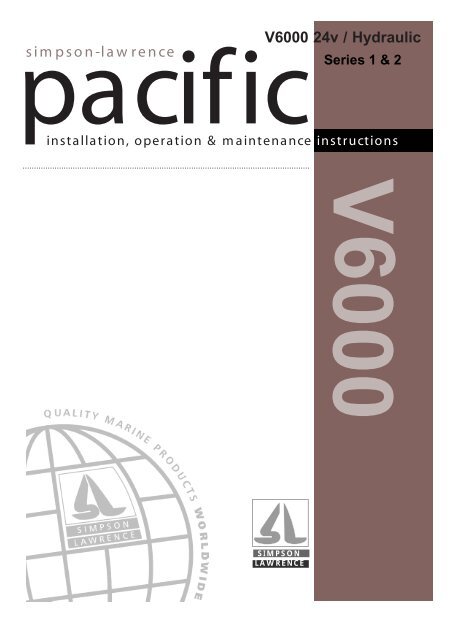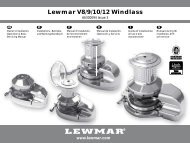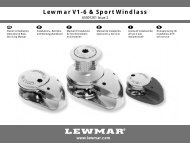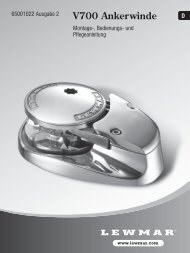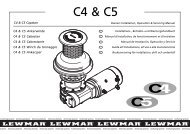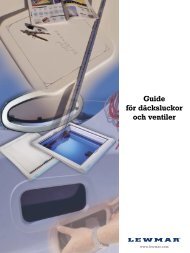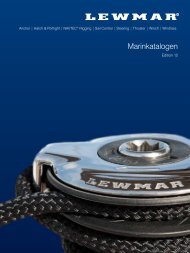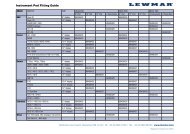You also want an ePaper? Increase the reach of your titles
YUMPU automatically turns print PDFs into web optimized ePapers that Google loves.
sim pson-la w rence<br />
24v<br />
pacificV6000<br />
insta lla tion, opera tion & m a intena nce instructions<br />
..............................................................................................................................<br />
1<br />
SIMPSON<br />
LAWRENCE<br />
/ Hydraulic<br />
V6000
2<br />
10<br />
11<br />
40<br />
12<br />
13<br />
64<br />
7<br />
50<br />
53<br />
56<br />
5<br />
5a<br />
61
43<br />
Right hand panel shows parts that<br />
are unique to 24v DC drive<br />
windlasses. See separate page<br />
for hydraulic “arf” braked drive .<br />
43<br />
48
Parts list: Ref 606001A.xls<br />
Parts list for V6000GD24v right or left hand<br />
Diag ref Part Qty Description<br />
1 103005 1 Bearing<br />
2 406058 1 Inner clutch nut assembly<br />
4 103036 1 Shim bearing, gearbox<br />
5 103025 1 Shim bearing, lower clutch<br />
5a 154418 1 Spacer, adjusting, lower clutch<br />
6 103026 1 Shim bearing, emergency wind<br />
7 103074 1 Shim bearing main lower<br />
8 103057 1 Bearing pad, emergency wind<br />
9 106025 1 Capstan<br />
10 106206 1 Cap outer<br />
11 106226 1 Cap inner<br />
12 106218 1 Cap lock<br />
13 106319 1 Clutch nut<br />
14 106416 1 Lower clutch<br />
15 106413 1 Upper clutch<br />
16 106540 1 Cover right hand (illustrated)<br />
16 106541 1 Cover left hand (not illustrated)<br />
17 106525 1 Stripper right hand (illustrated)<br />
17 106527 1 Stripper left hand (not illustrated)<br />
18 106537 1 Chain pipe right hand (illustrated)<br />
18 106539 1 Chain pipe left hand (not illustrated)<br />
19 109022 1 Deck housing right hand (illustrated)<br />
19 109023 1 Deck housing left hand (not illustrated)<br />
20 109307 1 Deckclamp<br />
21 113020 1 Key, woodruff<br />
22 118197 1 Pinion emergency wind<br />
23 119010 1 Gearbox<br />
24 1206XX 1 Gypsy (specify no. of teeth & chain)<br />
26 136018 1 Motor flange DC<br />
27 136059 1 Motor adaptor d drive<br />
28 136065 1 Motor coupling<br />
29 151213 1 Ratchet pawl<br />
30 151218 1 Ratchet housing right hand (illustrated)<br />
30 151219 1 Ratchet housing left hand (not illustrated)<br />
31 154004 6 Stud<br />
32 154223 1 Spring ratchet<br />
33 154219 1 Spring gypsy lift<br />
34 154221 1 Spring upper clutch<br />
35 154407 1 Screw chain pipe cover<br />
37 336033 1 Motor cima 24V-1500w<br />
38 339031 6 Nut hex<br />
39 342010 1 O ring<br />
40 342030 1 O ring<br />
41 342045 1 O ring<br />
42 342046 2 O ring<br />
43 342053 1 O ring<br />
44 342453 1 O ring<br />
46 354014 6 Capscrew
47 354230 6 Setscrew<br />
48 354015 9 Capscrew<br />
49 354049 3 Capscrew<br />
50 354032 3 Capscrew<br />
52 354232 3 Setscrew<br />
53 354242 3 Setscrew<br />
54 354333 2 Setscrew<br />
55 366042 3 Washer<br />
56 366051 3 Washer<br />
57 366061 6 Washer<br />
58 403042 1 Negative brake link<br />
59 406103 1 Brake assembly 24v<br />
60 418028 1 Stage 1 + motor pinion<br />
60 418058 1 Stage 2<br />
60 418066 1 Stage 3<br />
61 418100 3 Grease nipple<br />
62 421003 1 Emergency handle<br />
63 466013 1 Ratchet kit right hand<br />
63 466014 1 Ratchet kit left hand (not illustated)<br />
64 103014 1 Upper main bearing<br />
65 121016 1 Clutch nut key
40<br />
55<br />
2<br />
45<br />
61<br />
10<br />
53<br />
12<br />
13
43<br />
Right hand panel shows parts<br />
that are unique to 24v DC drive<br />
windlasses. See separate page<br />
for hydraulic “arf” braked drive .<br />
48
Parts list: Ref 606001A.xls<br />
Parts list for V6000GD24v right or left hand<br />
Diag ref Part Qty Description<br />
1 103005 1 Bearing<br />
2 406058 1 Inner clutch nut assembly<br />
4 103036 1 Shim bearing, gearbox<br />
5 103025 1 Shim bearing, lower clutch<br />
5a 154418 1 Spacer, adjusting, lower clutch<br />
6 103026 1 Shim bearing, emergency wind<br />
7 103024 1 Shim bearing main<br />
8 103057 1 Bearing pad, emergency wind<br />
9 106025 1 Capstan<br />
10 106208 1 Cap outer<br />
11 106226 1 Cap inner<br />
12 106218 1 Cap lock<br />
13 406056 1 Clutch nut assembly<br />
14 106415 1 Lower clutch<br />
15 106413 1 Upper clutch<br />
16 106540 1 Cover right hand (illustrated)<br />
16 106541 1 Cover left hand (not illustrated)<br />
17 106525 1 Stripper right hand (illustrated)<br />
17 106527 1 Stripper left hand (not illustrated)<br />
18 106537 1 Chain pipe right hand (illustrated)<br />
18 106539 1 Chain pipe left hand (not illustrated)<br />
19 109022 1 Deck housing right hand (illustrated)<br />
19 109023 1 Deck housing left hand (not illustrated)<br />
20 109307 1 Deckclamp<br />
21 113020 1 Key, woodruff<br />
22 118197 1 Pinion emergency wind<br />
23 119010 1 Gearbox<br />
24 1206XX 1 Gypsy (specify no. of teeth & chain)<br />
26 136018 1 Motor flange DC<br />
27 136059 1 Motor adaptor d drive<br />
28 136065 1 Motor coupling<br />
29 151213 1 Ratchet pawl<br />
30 151218 1 Ratchet housing right hand (illustrated)<br />
30 151219 1 Ratchet housing left hand (not illustrated)<br />
31 154004 6 Stud<br />
32 154223 1 Spring ratchet<br />
33 154219 1 Spring gypsy lift<br />
34 154221 1 Spring upper clutch<br />
35 154407 1 Screw chain pipe cover<br />
37 336033 1 Motor cima 24V-1500w<br />
38 339031 6 Nut hex<br />
39 342010 1 O ring<br />
40 342030 1 O ring<br />
41 342045 1 O ring<br />
42 342046 2 O ring<br />
43 342053 1 O ring<br />
44 342453 1 O ring<br />
45 354018 4 Capscrew<br />
46 354014 6 Capscrew
47 354230 6 Setscrew<br />
48 354015 9 Capscrew<br />
49 354049 3 Capscrew<br />
50 354032 3 Capscrew<br />
52 354232 3 Setscrew<br />
53 354242 3 Setscrew<br />
54 354333 2 Setscrew<br />
55 366042 3 Washer<br />
56 366051 3 Washer<br />
57 366061 6 Washer<br />
58 403042 1 Negative brake link<br />
59 406103 1 Brake assembly 24v<br />
60 418028 1 Stage 1 + motor pinion<br />
60 418058 1 Stage 2<br />
60 418066 1 Stage 3<br />
61 418100 3 Grease nipple<br />
62 421003 1 Emergency handle<br />
63 466013 1 Ratchet kit
A<br />
D<br />
E<br />
H<br />
I<br />
J<br />
K<br />
L<br />
K<br />
N<br />
M<br />
O P<br />
B<br />
C<br />
F<br />
G<br />
Parts list - above deck<br />
V6000G<br />
Gypsy only version<br />
Ref Part Qty Description<br />
A 106206 1 Outer cap<br />
B 342052 1 O ring<br />
C 354032 3 Cap screw<br />
D 106225 1 Inner cap<br />
E 342030 1 O ring<br />
F 354242 1 Hex screw<br />
G 366051 1 Spring washer<br />
H 106218 1 Lock cap<br />
I 106313 1 Clutch nut<br />
J 106418 1 Upper clutch<br />
K 154219 2 Spring<br />
L 1206XX 1 Gypsy X=noteeth<br />
M 418100 2 Grease nipple<br />
N 106419 1 Lower clutch<br />
O 103027 1 Main bearing<br />
P 103025 1 Bearing washer<br />
Q 154420 1 Spacer ring<br />
- 421004 1 Clutch handle<br />
Other parts are as illustrated on other<br />
pages of manual.<br />
Ensure spacer “Q” is fitted to groove<br />
at bottom of spline before fitting upper<br />
spring “K”<br />
Q
5.5.0 Wiring Diagrams<br />
5.5.1 Single Direction Wiring (High Load Foot Switch Only)<br />
D<br />
Series Wound<br />
Windlass Motor<br />
+ - +<br />
Total Length Required = A + B + C + D<br />
C<br />
High L oad<br />
Foot S witc h<br />
0052516<br />
NOTE: ALL installations must be carried out in accordance with USCG,<br />
ABYC and NMMA requirements. If you have any questions<br />
regarding this installation contact nearest Simpson-Lawrence Agent.<br />
WIRE FROM TO<br />
Thick cable Positive battery terminal High load foot switch<br />
Thick cable High load foot switch Windlass positive terminal<br />
Thick cable Negative battery terminal Windlass negative terminal<br />
B<br />
C irc uit<br />
B reaker / Is olator<br />
0050711 - 12V /70A<br />
B attery<br />
A
5.5.2 S ingle Direc tion Wiring<br />
D<br />
Series Wound<br />
Windlass Motor<br />
+ - +<br />
Deck<br />
Foot S witc h<br />
0052514<br />
Total Length Required = A + B + C + D<br />
WIR E F R OM T O<br />
T hick cable P ositive battery terminal B reaker / Isolator<br />
T hick cable B reaker / Isolator S olenoid<br />
T hick cable S olenoid Motor positive terminal<br />
T hick cable Negative battery terminal Negative motor terminal<br />
T hin wire S olenoid C ontrol switch(es)<br />
T hin wire C ontrol switch(es) In line fuse<br />
T hin wire In line fuse Main circuit (positive)<br />
T hin wire S olenoid Main circuit (negative)<br />
NB Use a minimum wire gauge of 1.5mm 2 (14AWG ) to connect switches.<br />
C<br />
S ingle Direc tion S olenoid<br />
0052506 - 24V<br />
One control will operate the windlass, though more than one may be fitted.<br />
High L oad<br />
Foot S witc h<br />
0052516<br />
Remote Hand Switch<br />
In L ine F us e<br />
24V - 3.15 Amp<br />
B<br />
0052515<br />
Battery<br />
C irc uit<br />
B reaker / Is olator<br />
0050711 - 12V /70A<br />
A
D<br />
E<br />
Series W ound<br />
Windlass Motor<br />
+ - +<br />
F<br />
Deck Foot S witc h<br />
0052514 x 2<br />
Down Up<br />
Do wn<br />
S W Motor<br />
Commom P ositive<br />
Up<br />
R emote Hand S witc h<br />
Fuse<br />
B attery<br />
0052515<br />
Total Length Required = A + B + C + D + E or F<br />
One Control will operate the windlass, though more than one control may be fitted. If the<br />
windlass operates in the opposite sense to all of the controls fitted, swap around the UP<br />
and DOWN wires at the reversing solenoid box.<br />
B rake<br />
B<br />
P us h B utton<br />
Double<br />
0052513<br />
Up/Down<br />
R ocker S witc h<br />
0052518<br />
White<br />
R ed<br />
B lue<br />
Power R evers ing S olenoid Bx o<br />
for S eries Wound Motors<br />
0052530 - 24V<br />
C<br />
Batter y<br />
C irc uit<br />
B reaker / Is olator<br />
0050711 - 12V /70A<br />
A
Identification aid<br />
Output shaft is<br />
hexagonal for all<br />
C3500 & V4000<br />
winches.<br />
Output shaft is<br />
round with spline<br />
for all V6000<br />
winches<br />
11<br />
Ref:ARF01.pub<br />
1<br />
2<br />
3<br />
4<br />
5<br />
6<br />
7<br />
8<br />
9<br />
10<br />
Ref:ARF01<br />
Transmission Parts List<br />
C3500ARF Capstan<br />
V4000GARF, V4000GDARF Windlass<br />
V6000GARF, V6000GDARF Windlass<br />
All other parts of winch are as shown on DC electric<br />
powered parts diagram.<br />
When ordering parts, give full description of part item required,<br />
winch model, and all details from nameplate(s)<br />
Ref Part Description Quantity used per winch<br />
number C3500 V4000G V4000GD V6000GV6000GD<br />
1418065 Final drive 1<br />
418063 1<br />
418064 1<br />
418067 1<br />
418066 1<br />
2 106602 Pinion 1 1 1<br />
106604 1 1<br />
3 106606 Coupling 1 1 1<br />
106603 1 1<br />
4 342051Seal 1 1 1<br />
342053 11<br />
5 354032 Screw 6 6 6<br />
354050 8 8<br />
6 119056 Adaptor 1 1 1<br />
119053 1 1<br />
7 354032 Screw 6 6 6<br />
354044 6 6<br />
8 342042 Seal 11 1 1 1<br />
9 354060 Screw 2 2 2 4 4<br />
10 336054 Motor 1 1 1<br />
336053 11<br />
11 - Key 1 1 1 1 1<br />
Servicing this transmission unit.<br />
1] Disconnect hydraulic lines. Plug motor ports and line ends to<br />
ensure no contamination of oil system.<br />
2] Remove winch from istallation and secure in upside down position.<br />
3] Do not dis assemble motor/brake unit - item 10. This should be<br />
serviced by an authorised service agent.<br />
4] If necessary remove components following diagram. Clean all<br />
parts thoroughly.<br />
5] Removal of final drive requires release of centre screw at top<br />
end of winch. Final drive should fit freely in housing<br />
6] Keep screw thread holes clean and free of lubricant. These<br />
must be kept clean for thread lock compound on assembly<br />
7] With final drive in position and secured by centre screw (not<br />
shown), fill gear box to top with fluid grease (Castrol TC or similar<br />
00 grade fluid grease). Rotate gear train and top up. Assemble in<br />
sequence filling voids with grease. Apply locking compound to all<br />
screw threads and tighten evenly and firmly.<br />
8] After a few hours use, check all fastenings are tight and re check<br />
from time to time. Follow standard commissioning procedures for<br />
hydraulic sytems<br />
Manufactured by James Nilsson Ltd, 69 Hillside Road, Glenfield,<br />
Auckland, New Zealand. Tel: ++649 444 5219 Fax: ++ 649 444 5222<br />
Email: sales@jamesnilsson.co.nz
Tuesday, October 09, 2001 19:27:06
5.0 INSTALLATION<br />
5.1 .0 Fitting Windlass To Deck<br />
5.1 .1 Preparation<br />
If the deck top is uneven a suitable mounting pad may be<br />
required to take up camber or sheer. Decks which are thin, of<br />
foam or balsa laminate construction, will require a backing piece<br />
in order to spread the load which will be applied locally to the<br />
deck while the windlass is in use. Care must be taken if the<br />
deck is of uneven thickness and a mounting pad and/or backing<br />
piece fitted that the top and bottom surfaces are parallel for<br />
optimum clamping.<br />
5.1 .2 Position of Windlass<br />
Select a site for the windlass that allows for the following:<br />
a. An unobstructed route for the chain from the stemhead<br />
roller to the gipsy. The chain should enter the gipsy at<br />
a point 90° to the main windlass centre line.<br />
b. The chain locker or storage area under the windlass<br />
should be as deep as possible and preferably of a tall<br />
and narrow design. The highest point of the stowed<br />
chain heap should ideally be 300 -400mm (1-1½ft)<br />
below the windlass motor.<br />
c. The footswitch(es) should be positioned to allow the<br />
operator to comfortably tail rope off the drum when<br />
necessary.<br />
d. The top of the windlass must be accessible for<br />
greasing and clutch operation.<br />
5.1 .3 Mounting Template<br />
Place the mounting template in the desired position. Drill the<br />
holes for the motor and chain to pass through as detailed and<br />
six 10mm (3/8") holes for the studs. The studs supplied suit<br />
decks and mounting pads up to 75mm (3") thickness.<br />
5.1 .4 Fitting<br />
P lac e the windlas s and s tuds through the holes in the dec k,<br />
when s atis fied that all is c orrec t, fit any pac king, the c lamping<br />
ring and the nuts and was hers and tighten evenly and firmly<br />
us ing a 150mm (6" ) long s panner.<br />
5.1 .5 Longer Studs<br />
F or thic ker than s tandard dec ks , s imply fit longer s tuds as<br />
appropriate (M8 T hread). S tuds to s pec ial lengths may be<br />
obtained from S imps on-L awrenc e E ngineering L imited.<br />
5.2 .0<br />
5.2 .1<br />
Wiring<br />
General Recommendations<br />
T he wiring s ys tem s hould be of the two c able fully ins ulated<br />
return type, whic h avoids pos s ible elec trolytic c orros ion<br />
problems . Mos t modern ins tallations are negative return<br />
(negative earth) but polarity s hould be c hec ked.<br />
S olenoids s hould be mounted as c los e to the battery as<br />
pos s ible, in a dry loc ation us ing the mounting holes provided.<br />
Under no c irc ums tanc es s hould s olenoids or s olenoid c ontrol<br />
boxes be ins talled in c hain loc kers or s imilar damp or s emi<br />
expos ed areas .<br />
Overload protec tion mus t be built into the windlas s wiring<br />
c irc uit. T his protec ts the wiring and prevents undue damage to<br />
the windlas s motor, in the event of it being s talled by an<br />
exc es s ive load in s ervic e. It is advis able to s ite the B reaker/<br />
Is olator in a dry, readily ac c es s ible plac e, as it mus t be<br />
manually res et s hould an overload oc c ur that c aus es it to trip to<br />
the OFF pos ition.<br />
If you are NOT us ing the B reaker/Is olator rec ommended, an<br />
alternative MUST have identic al c harac teris tic s .<br />
NB: C rimp terminals s hould be us ed on all wire ends for good<br />
elec tric al c onnec tions .<br />
5.2.2 Control Switch Installation<br />
F ollow the mounting ins truc tions s upplied with the s witc h.<br />
R emember when us ing more than one c ontrol s witc h, it is<br />
important to their c orrec t operation, that they are wired in a<br />
parallel c irc uit.<br />
5.3 Test<br />
Immediately after installation , it is rec ommended that the<br />
winc h is tes ted to ens ure it func tions c orrec tly in all modes , e.g.,<br />
forward, revers e and manual operations s hould be tes ted.<br />
5.4 Protection of Below Deck Parts<br />
C hec k all terminals or c onnec tions are firmly s ec ured. C oat<br />
ALL below dec k s urfac es , inc luding the terminals , with rubber<br />
or plas tic type paint (automotive unders eal is one c onvenient<br />
way) OR wrap c ompletely in s elf amalgamating tape OR c oat/<br />
protec t in a s imilar way with s ome other s ys tem s uitable for a<br />
marine environment.
6.0 OP E R A T ING INS T R UC T IONS<br />
6.1 S afety F irs t!<br />
Y our S impson-Lawrence P acific winch is a powerful piece of<br />
equipment and should be respected as such. K eep young<br />
children and observers, who are unfamiliar with anchoring<br />
procedures, away from the operating area when in use. T o<br />
avoid personal injury, ensure that fingers, limbs and clothing are<br />
kept clear of the rode and windlass during operation. Always<br />
ensure there are no swimmers nearby when dropping your<br />
anchor.<br />
Always keep the Isolator switch OF F except when in use.<br />
C hain P ipe C over<br />
C lutch Nut<br />
Drum<br />
G ipsy<br />
B rake Module Deck C lamp<br />
Motor<br />
C lutch Handle F its Here<br />
R atchet Actuator<br />
6.2 Us e Of C lutc h<br />
T o tighten the clutch - rotate the clutch nut clockwise, this will<br />
grip the gipsy, effectively locking it to the windlass geartrain.<br />
T o slacken the clutch - turn the nut anti-clockwise, this will free<br />
the gipsy allowing it to turn independently of the windlass<br />
geartrain.<br />
A lways remove the handle after us e.<br />
R atchet<br />
Actuator<br />
E ngage<br />
C lutch Handle F its Here<br />
Disengage<br />
Disengage C lutch<br />
E ngage C lutch<br />
6.3 Us e Of G ips y R atc het<br />
T he gipsy spring ratchet is controlled by the lever on the side of<br />
the chain pipe. C lockwise rotation of the lever disengages the<br />
ratchet from the gipsy, which is then free to rotate in either<br />
direction. Anti-clockwise rotation of the lever engages the<br />
ratchet with the gipsy, preventing chain run out, i.e., when the<br />
gipsy rotates anti-clockwise.<br />
T o prevent damage, NE V E R have the ratc het engaged when<br />
letting c hain out!<br />
6.4.0 A nc hor R eleas e<br />
6.4.1 Under P ower<br />
When the power reversing option is used, the anchor and chain<br />
can be lowered at a regular rate by activating the DOWN control.<br />
E nsure that the clutch is tightened and that the gipsy ratchet is<br />
disengaged. P ower out the desired length of chain. Use<br />
controlled boat motion in the direction of the prevailing wind or<br />
current to set the anchor into the sea bed. S ecure as detailed in<br />
section 6.5.<br />
6.4.2 Under G ravity<br />
E nsure that the gipsy ratchet is disengaged. C arefully release<br />
the clutch to allow the anchor and chain to pay out under gravity.<br />
Use the clutch as a brake to control the run of the chain if<br />
necessary. When the anchor is set, secure rode as detailed in<br />
6.5.<br />
6.5 L ying T o A nc hor<br />
T o avoid direct loading on the windlass while lying at anchor,<br />
use a chain stopper or heavy nylon bridle to secure rode to an<br />
independent s trong point. When using rope, it should be<br />
made fast to a sampson post, bollard, or mooring cleat.<br />
6.6 A nc hor R ec overy<br />
Use firm hand pressure to tighten the clutch, DO NOT force or<br />
hammer the clutch nut! E nsure that the gipsy ratchet is<br />
disengaged and visually check that the foredeck is clear around<br />
the windlass. C heck that there are no swimmers, divers, etc., in<br />
the vicinity.<br />
It is recommended that the ship's engine is run during anchor<br />
recovery.<br />
Activate the windlass by using a foot switch, hand switch control,<br />
etc., using the windlass' power to bring the boat over the site of<br />
the anchor. Maintaining a slow speed whilst approaching the<br />
anchor is a good safe practice, especially in a crowded<br />
anchorage. If the anchor is snagged and/or heavy loads are<br />
being applied by the windlass, use the ship's engine to<br />
manoeuvre over the anchor to help free it. DO NOT hurry the<br />
operation. T he hauling speed depends on the load placed on<br />
the anchor, remember that it will increase after the anchor<br />
breaks free. As the anchor approaches the stemhead, the chain<br />
should be slowly and carefully landed with the use of the<br />
controls to avoid damage to the vessel and its fittings. S hould<br />
the windlass stall, switch it OF F immediately and wait a few<br />
minutes before trying again. If the breaker/isolator has tripped, it<br />
will require to be manually reset before the windlass can be used<br />
again. If the breaker/isolator proves difficult to reset, allow it to<br />
cool for a few moments. Avoid stalling your windlass whenever<br />
possible.<br />
6.7 Warping<br />
Load<br />
C lutch Disengaged<br />
Lay Onto Drum C lockwise<br />
Hand Over Hand<br />
(Tailing)<br />
B efore warping, if the anchor is in use, secure anchor rope/chain<br />
to an independent s trong point. Otherwise secure anchor and<br />
anchor rope/chain to an independent s trong point. S lacken<br />
the clutch nut to enable the drum to rotate independently of the<br />
gipsy. Wrap at least three coils of rope, loosely, around the<br />
drum clockwise to avoid it slipping. Apply a light hand pressure<br />
on the tail of the warp and apply power. While the windlass<br />
rotates under power, tail the warp hand over hand until the task<br />
is complete. S ecure the warp after use.
6.8 E mergenc y Hand G ear Operating Ins truc tions<br />
2. S witch lever to manual then<br />
unscrew the chain pipe cover screw<br />
and remove the cover.<br />
4. Once anchor rope/chain is fully<br />
recovered, secure to an<br />
independant s trong point, remove<br />
operating handle, replace chain pipe<br />
cover and revert switch lever to<br />
power on.<br />
1. Isolate the windlass using the circuit<br />
breaker/isolator.<br />
WA R NING ! Do not switch on power<br />
when the ratchet pawl actuator is in the<br />
manual ( ) position.<br />
3. R elease clutch nut, then<br />
insert emergency handle into the<br />
chain stripper and turn in an<br />
anti-clockwise direction until<br />
anchor rope/chain is fully<br />
recovered.<br />
6.9 Operating T ips<br />
It is recommended that the boat engine should be running when<br />
hauling in the anchor so that the helmsman can gain immediate<br />
control of the craft if necessary after the anchor breaks free.<br />
When mooring stern to, drop the anchor at the required<br />
distance from the jetty and gently ease off the gipsy clutch just<br />
enough to allow the chain to run out under the influence of the<br />
stern way of the vessel, thus preventing the bows from<br />
swinging. B y engaging the clutch fully, the anchor can be used<br />
to restrain the vessel as it approaches the jetty. Make fast with<br />
warps from the stern.<br />
6.10.1 Warning!<br />
If the correct installation procedure is followed, it should not be<br />
necessary to dismantle any part of the windlass.<br />
'O' ring seals are used extensively in the construction of this<br />
windlass and if any seals are broken, special care must be<br />
taken to ensure correct positioning of the seals and that they<br />
are not pinched when re-assembling.<br />
6.10.2 T o C hange G ips y<br />
1. R emove top cap<br />
2. R emove inner cover and seal. DO NOT remove central<br />
hexagon screw under inner cover.<br />
3. Unscrew clutch nut and remove drum, top clutch, spring<br />
and spring retainer.<br />
4. R emove chain pipe cover and 2 hexagon screws holding<br />
the stripper.<br />
5. R otate the stripper away from the gipsy and lift the gipsy off.<br />
6. P ut new gipsy into place taking care to fit the internal shim<br />
bearing if the gipsy has a groove in the bore. T he gipsy<br />
must engage with the emergency pinion. DO NOT F OR C E .<br />
7. Assemble in reverse order, taking care to screw fastenings<br />
down firmly but WIT HOUT US ING F OR C E .<br />
6.10.3 Warning!<br />
S erious damage c an be c aus ed by inc orrec t as s embly and<br />
your guarantee may be invalidated as a res ult. A lways<br />
proc eed with c are. T he P acific family of windlasses have<br />
been designed for ease of installation and removal. It should<br />
not be necessary to remove any parts other than the deck<br />
clamping ring, nuts and washers.<br />
6.11 Ordering a G ips y<br />
S hould you ever have to order a replacement gipsy it should be<br />
noted that the part number has five digits and the suffix X. T he<br />
X refers to the number of pockets or chain teeth on the gipsy.<br />
7.0 IMP OR T A NT US E R INF OR MA T ION<br />
C lassification S ocieties require that a vessel lying to anchor<br />
should have its rode held by a chain stopper or equivalent<br />
strong point as windlasses are not designed to withstand the<br />
loads generated under storm conditions. T his rule should be<br />
applied to all craft!<br />
At all times it is the responsibility of the boat user to ensure that<br />
the anchor and rode are properly stowed for the prevailing sea<br />
conditions. T his is particularly important with high speed power<br />
boats as an anchor accidentally falling into the water whilst<br />
under way can cause considerable damage.<br />
An anchor windlass is mounted in the most exposed position on<br />
a vessel and is thus subject to severe atmospheric attack<br />
resulting in a possibility of corrosion in excess of that<br />
experienced with most other items of deck equipment.<br />
As the windlass may only be used infrequently, the risk of<br />
corrosion is further increased.<br />
When the windlass is mounted in an anchor well with a closing<br />
lid, due to lack of ventilation and consequent high saline<br />
conditions the rate of corrosion is accelerated. It is essential<br />
that the windlass is regularly examined, operated and given any<br />
necessary maintenance. T his is of even greater importance<br />
when the windlass is installed in an anchor well!<br />
8.0 MA INT E NA NC E<br />
R emove C over For<br />
Access to G rease<br />
Points Underneath<br />
Keep Motor<br />
C lean and Dry<br />
C over<br />
8.1 G eneral R ec ommendations<br />
Isolate the windlass electrically, before carrying out any<br />
maintenance work.<br />
After the first two or three anchor recoveries, check that the<br />
windlass is still fastened tightly to the deck as it should now be<br />
bedded-in. E very three months, remove the drum cap (P art<br />
no. 9) using a pocket knife or broad bladed tool. As the cap
9.0 THREE Y EA R LIM ITED W A RRA NTY<br />
W A RRA NTY COV ERA GE: S IMP S ON-LAWR E NC E LIMIT E D., warrants to the original purchaser, subject to the limitations<br />
and exclusions described below, that this product will be free from defects, in material and workmanship under normal use<br />
and service, for a period of three (3) years from the date of its original sale, except that the warranty shall be for a period of<br />
one (1) year for seals, electric motors, electrical equipment, electronic controls, composite gipsies and hydraulic pumps.<br />
S impson-Lawrence will repair or replace any part which proves to be defective in normal use during the period of the<br />
warranty.<br />
W A RRA NTY CLA IM S PROCEDURES: If a defect is discovered during the applicable warranty period, B uyer must<br />
promptly notify S impson-Lawrence of such, in writing, at the nearer address below, providing proof of purchase. F or<br />
warranty service, the product must be returned to S impson-Lawrence for examination. T his examination will be performed<br />
by S impson-Lawrence at no charge to B uyer. B uyer is responsible for any labour costs associated with preparing the<br />
product or parts for shipping and the cost of shipping or transporting the product or parts to and from S impson-Lawrence.<br />
REM EDY : S impson-Lawrence will repair any defect in material or workmanship or, at it’s option, correct such defect by<br />
replacing non-conforming goods or parts. S uch repairs and/or new parts are warranted for the unexpired portion of the<br />
original warranty, or for 90 days, whichever is later. Warranty work (parts and/or Labour) shall be at S impson-Lawrence’s<br />
expense; however, product preparation and shipping costs to or from S impson-Lawrence shall be borne by B uyer. T hese<br />
remedies are the B uyer’s exclusive remedies for breach of warranty.<br />
LIM ITA TIONS A ND EXCLUSIONS: (1) T his warranty applies only if the product is used under non-commercial, normal<br />
use in service, and shall not apply to (a) products subjected to (i) conditions or usage that exceed the product’s<br />
performance specifications, (ii) incorrect maintenance, or (iii) use in applications for which they are not intended; (b)<br />
defects or damage caused by a force majeure which exceed design specifications, including but not limited to, wear and<br />
tear, corrosion or ultraviolet degradation; and (c) defects or damages caused by unauthorized attachments, accessories or<br />
modifications. (2) S impson-Lawrence’s warranties of fitness and merchantability, as well as other expressed warranties<br />
contained herein, shall apply only to those parts and components manufactured by S impson-Lawrence, which were<br />
installed by S impson-Lawrence or other authorized personnel, and shall not be effective or actionable if any warranty<br />
repair or replacement work is performed by any unauthorized party. S impson-Lawrence reserve the right to alter the<br />
products specifications and design without prior notice.<br />
THE FOREGOING W A RRA NTIES A RE EXCLUSIV E A ND IN LIEU OF A LL OTHER EXPRESSED W A RRA NTIES.<br />
IM PLIED W A RRA NTIES, INCLUDING BUT NOT LIM ITED TO THE IM PLIED W A RRA NTIES OF M ERCHA NTA BILITY<br />
A ND FITNESS FOR A PA RTICULA R PURPOSE, DO NOT EXTEND BEY OND THE DURA TION OF THE EXPRESSED<br />
W A RRA NTIES PROV IDED HEREIN.<br />
IN NO CA SE SHA LL SIM PSON-LA W RENCE BE LIA BLE FOR A NY SPECIA L, INCIDENTA L OR CONSEQUENTIA L<br />
DA M A GES BA SED UPON BREA CH OF W A RRA NTY , BREA CH OF CONTRA CT, NEGLIGENCE, STRICT TORT OR<br />
A NY OTHER LEGA L THEORY . THIS LIM ITA TION DOES NOT A PPLY TO CLA IM S FOR PERSONA L INJURY .<br />
SOM E STA TES, OR COUNTRIES, DO NOT A LLOW THE EXCLUSION OR LIM ITA TION OF INCIDENTA L OR<br />
CONSEQUENTIA L DA M A GES OR LIM ITA TIONS ON HOW LONG A N IM PLIED W A RRA NTY LA STS, SO THE A BOV E<br />
LIM ITA TIONS OR EXCLUSIONS M A Y NOT A PPLY TO Y OU.<br />
THIS W A RRA NTY GIV ES Y OU SPECIFIC LEGA L RIGHTS A ND Y OU M A Y A LSO HA V E OTHER RIGHTS W HICH<br />
V A RY FROM STA TE TO STA TE, OR COUNTRY TO COUNTRY .<br />
The model described in this document is subject to a policy of continual improvement. Simpson-Lawrence Engineering Limited<br />
reserve the right to alter specifications and recommendations without notice. For the latest information regarding any aspect<br />
of your windlass please contact your local agent or Simpson-Lawrence Engineering Limited:-<br />
All spares and technical queries on this product should be directed to the manufacturers:<br />
James Nilsson Ltd<br />
Winchmakers<br />
69 Hillside road, Glenfield, Auckland<br />
New Zealand<br />
Tel:{**649} 444 5219 Fax:{**649} 444 5222
SIM PSON<br />
LA W RENCE


